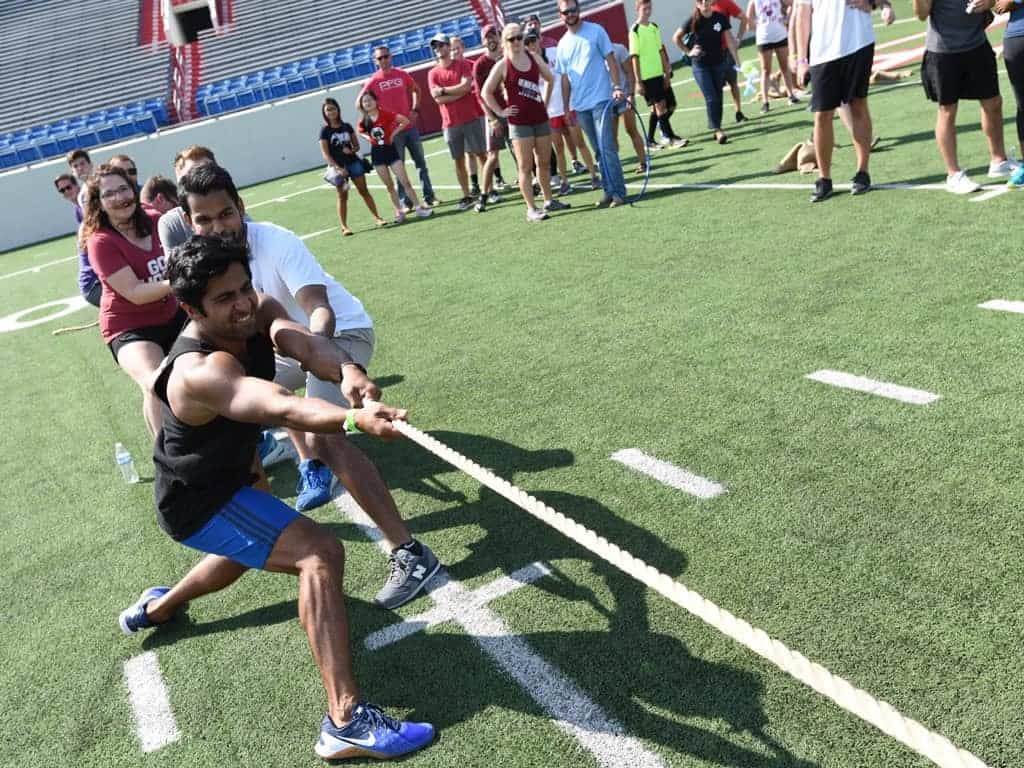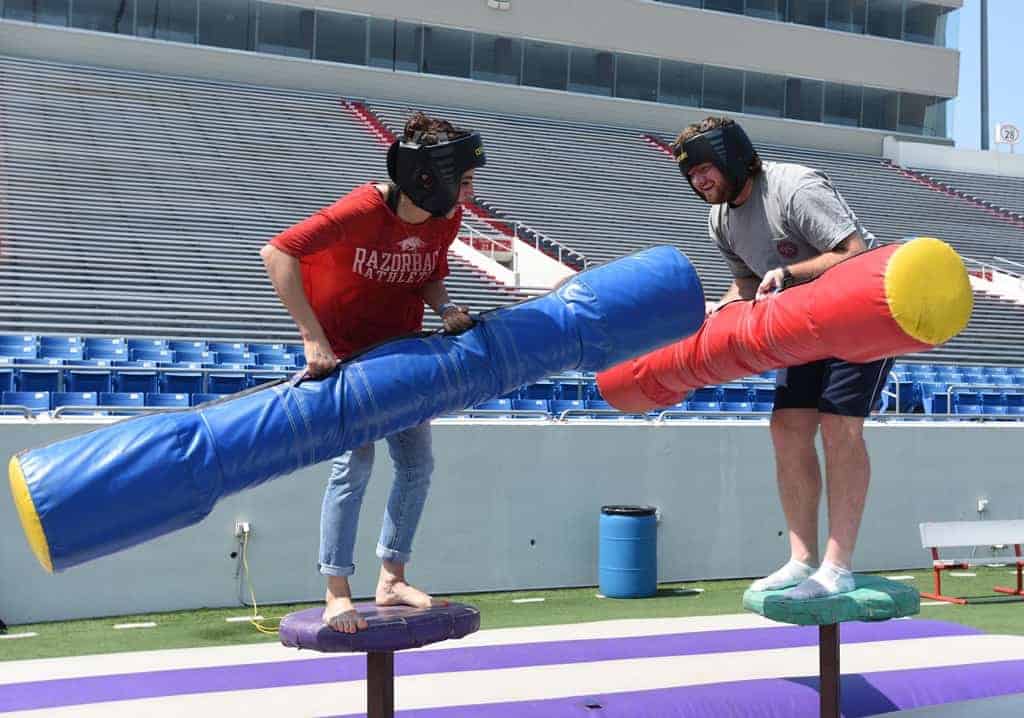Sept. 15, 2017 | UAMS College of Medicine students gathered with faculty members, family and friends on the field at War Memorial Stadium on a September Saturday afternoon that started with food and games and ended with students literally pulling for one another.

Just as in the tug-of-war matchups that capped the events at the college’s first annual Academic House Olympics, students and faculty in the college’s seven academic houses pull for one another throughout the students’ four years of medical education.
“Medical school poses some of the greatest challenges and most difficult coursework that any students face,” said Sara Tariq, M.D., an associate professor of internal medicine and assistant dean for undergraduate clinical education in the college. “We established academic houses in 2016 to help students connect and mentor one another and develop meaningful relationships with faculty members. In short, our academic houses also help students deal with the stress of medical school.”

The houses are structured learning communities, not physical residences. Each house consists of students from all four years and specially trained physician and basic sciences faculty advisers. Many house activities focus on academic success and preparation for crucial milestone events such as national exams and the increasingly competitive National Resident Matching Program, which determines where physicians will train after graduation. The interaction of students in different class years encourages peer mentoring as students gear up for these challenges.
“We know that sustained professional and personal relationships between students and faculty and among peers contribute to effective learning,” Tariq said. “This is one reason about 60 medical schools across the country – about 40 percent of U.S. medical schools – have adopted academic houses or similar learning communities.”
“Ultimately, we want to ensure that our students are successful in medical school, in the residency match and beyond,” said Pope L. Moseley, M.D., who advocated for implementing academic houses after his recruitment to UAMS as executive vice chancellor and College of Medicine dean in 2015. “We want our students to reach their full potential academically, personally and professionally.”

The Olympics was planned as a way for students, faculty and families to get to know one another outside of the classroom and build bonds. Music filled the stadium until the mid-afternoon kickoff of an Arkansas Razorbacks game, which was played on the Jumbotron. Colorful banners, balloons and other decorations adorned picnic awnings set up by each academic house.
“This is a lot of fun and a totally stress-free day for us,” Nawar Hudefi, a junior, said after hopping down from a giant inflatable jousting ring. She had just used an oversized baton to defeat her classmate, Ru Massey, in a laughter-filled duel. Massey agreed, adding that the event was an opportunity to meet or become better acquainted with students from other houses and class years.

The seven academic houses were named by students last year in honor of successful UAMS alumni, iconic faculty members, prominent Arkansas physicians and other leaders (all deceased) who made their mark on Arkansas and medicine. Hudefi’s house, for example, is named after George William Stanley Ish, M.D., a Harvard-trained African-American physician who cared for citizens in Little Rock from the 1920s through the 1960s and founded a sanatorium for treating tuberculosis patients. Massey’s house is named after Patrick W. Tank, Ph.D., a nationally prominent anatomist who helped more than 4,000 medical students learn the complexities of the human body while serving on the College of Medicine faculty from 1978 to 2012.
At War Memorial, students vied for possession of the House Cup by earning points in half a dozen sports and other games as well as for overall participation and house spirit. In an unplanned, tie-breaking final obstacle course race, the day’s top honors went to the Lowe House, named after Betty A. Lowe, M.D., a 1956 alumna and highly respected pediatrics faculty member who helped Arkansas Children’s Hospital become one of the largest children’s hospitals in the country.
Several faculty members participated in activities, including a dunking booth that raised money for medical students affected by Hurricane Harvey in Texas and Hurricane Irma in Florida. Students, faculty and family members lined up for the chance to dunk some of their favorite teachers as well as the dean.
Priya Mendiratta, M.D., an associate professor of geriatrics, said she relishes her role as an adviser in the Beall House, named after Ruth Olive Beall, an early leader at Arkansas Children’s Hospital.
“It is wonderful to get to know our students better from their freshman year onward,” Mendiratta said. “They have so many leadership qualities, and we see more of those through the academic houses. Our houses, and events like this, give students and faculty a sense of being one big family. We all share the same goals in the education of these future physicians.”
Senior Cassandra Coleman Lautredou began serving as a student representative on the Leadership Council that helps to govern the seven houses at the program’s inception in August 2016. “We have basically been in the process of building what these academic houses really mean,” she said. “Through my leadership role in the Beall House, I have been able to work collaboratively with faculty and students. Prior to this experience I had not gotten to interact or work with UAMS faculty as much.”
“Our faculty advisers are fantastic,” Lautredou said, praising Mendiratta and Angela Scott, M.D., Ph.D., an assistant professor of pediatrics who was an active adviser in the house before assuming leadership of a major first-year course, Practice of Medicine I. “I know I can count on our faculty advisers if I need anything, whether it is house-related or not.”


